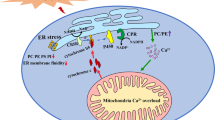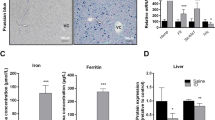Abstract
Purpose
Owing to its ability to inactivate harmful radicals, vitamin C plays a key role in antioxidant defense. The bioavailability of this vitamin depends upon the nutritional intake and its uptake by cells, mainly through the sodium-dependent transporters SVCT1/Svct1 and SVCT2/Svct2 (human/rat). Here, we investigated the effect of liver metabolic/oxidative stress on the expression of these transporters in extrahepatic tissues.
Methods and results
In Zucker rats, used here as a model of liver steatosis, Svct1-2 mRNA levels were similar in obese and lean animals, except for lung tissue, where Svct2 was up-regulated. Diabetes mellitus, developed by streptozotocin administration, was accompanied by a down-regulation of Svct1 in liver and kidney, together with a down-regulation of Svct2 in kidney and brain. Complete obstructive cholestasis due to bile duct ligation for 1 week induced a significant down-regulation of both Svct1 and Svct2 in ileum, whereas Svct2 was up-regulated in liver, and no significant changes in the expression of either transporter were found in kidney, brain or lung. In rat hepatoma Can-10 cells, bile acids, but not the FXR agonist GW4064, induced an up-regulation of Svct1 and Svct2. In human hepatoma Alexander cells transfected with FXR/RXRα/OATP1B1, neither GW4064 nor unconjugated or glycine-/taurine-conjugated major bile acids were able to up-regulate either SVCT1 or SVCT2.
Conclusions
Pathological circumstances characterized by the presence of metabolic/oxidative stress in the liver induce different responses in the expression of ascorbic acid transporters in intrahepatic and extrahepatic tissues, which may affect the overall bioavailability and cellular uptake of this vitamin.







Similar content being viewed by others
References
Wilson JX (2005) Regulation of vitamin C transport. Ann Rev Nutr 25:105–125. doi:10.1146/annurev.nutr.25.050304.092647
Dhariwal KR, Hartzell WO, Levine M (1991) Ascorbic acid and dehydroascorbic acid measurements in human plasma and serum. Am J Clin Nutr 54:712–716
Tsukaguchi H, Tokui T, Mackenzie B, Berger UV, Chen XZ, Wang Y, Brubaker RF, Hediger MA (1999) A family of mammalian Na + -dependent L-ascorbic acid transporters. Nature 399:70–75. doi:10.1038/19986
Marin JJ, Serrano MA, Perez MJ, Macias RI (2009) Molecular bases of the cellular handling of vitaqmin C. Transport and metabolism in health and disease. In: Columbus F (ed) Vitamin C: Daily Requirements. Dietary sources and adverse effects Nova Science Publishers, Hauppauge
Brubacher D, Moser U, Jordan P (2000) Vitamin C concentrations in plasma as a function of intake: a meta-analysis. Int J Vitam Nutr Res 70:226–237
Macias RI, Hierro C, de Juan SC, Jimenez F, Gonzalez-San Martin F, Marin JJ (2011) Hepatic expression of sodium-dependent vitamin C transporters: ontogeny, subtissular distribution and effect of chronic liver diseases. Br J Nutr 106:1814–1825. doi:10.1017/S0007114511002273
Michels AJ, Joisher N, Hagen TM (2003) Age-related decline of sodium-dependent ascorbic acid transport in isolated rat hepatocytes. Arch Biochem Biophys 410:112–120
Kuo SM, MacLean ME, McCormick K, Wilson JX (2004) Gender and sodium-ascorbate transporter isoforms determine ascorbate concentrations in mice. J Nutr 134:2216–2221
Leevy CM, Thompson A, Baker H (1970) Vitamins and liver injury. Am J Clin Nutr 23:493–499
Perez MJ, Castano B, Jimenez S, Serrano MA, Gonzalez-Buitrago JM, Marin JJ (2008) Role of vitamin C transporters and biliverdin reductase in the dual pro-oxidant and anti-oxidant effect of biliary compounds on the placental-fetal unit in cholestasis during pregnancy. Toxicol Appl Pharmacol 232:327–336. doi:10.1016/j.taap.2008.07.013
Perez MJ, Castano B, Gonzalez-Buitrago JM, Marin JJ (2007) Multiple protective effects of melatonin against maternal cholestasis-induced oxidative stress and apoptosis in the rat fetal liver-placenta-maternal liver trio. J Pineal Res 43:130–139. doi:10.1111/j.1600-079X.2007.00453.x
Mardones L, Zuniga FA, Villagran M, Sotomayor K, Mendoza P, Escobar D, Gonzalez M, Ormazabal V, Maldonado M, Onate G, Angulo C, Concha, II, Reyes AM, Carcamo JG, Barra V, Vera JC, Rivas CI (2012) Essential role of intracellular glutathione in controlling ascorbic acid transporter expression and function in rat hepatocytes and hepatoma cells. Free Radic Biol Med. doi:10.1016/j.freeradbiomed.2012.02.017
Ohta Y, Kongo M, Sasaki E, Ishiguro I, Harada N (2000) Protective effect of melatonin against alpha-naphthylisothiocyanate-induced liver injury in rats. J Pineal Res 29:15–23
Kashiba M, Oka J, Ichikawa R, Kasahara E, Inayama T, Kageyama A, Kageyama H, Osaka T, Umegaki K, Matsumoto A, Ishikawa T, Nishikimi M, Inoue M, Inoue S (2002) Impaired ascorbic acid metabolism in streptozotocin-induced diabetic rats. Free Radic Biol Med 33:1221–1230
Monte MJ, Morales AI, Arevalo M, Alvaro I, Macias RI, Marin JJ (1996) Reversible impairment of neonatal hepatobiliary function by maternal cholestasis. Hepatology 23:1208–1217. doi:10.1002/hep.510230540
Rakieten N, Rakieten ML, Nadkarni MR (1963) Studies on the diabetogenic action of streptozotocin (NSC-37917). Cancer Chemother Rep 29:91–98
Pizarro M, Balasubramaniyan N, Solis N, Solar A, Duarte I, Miquel JF, Suchy FJ, Trauner M, Accatino L, Ananthanarayanan M, Arrese M (2004) Bile secretory function in the obese Zucker rat: evidence of cholestasis and altered canalicular transport function. Gut 53:1837–1843. doi:10.1136/gut.2003.037689
Corpe CP, Burant CF (1996) Hexose transporter expression in rat small intestine: effect of diet on diurnal variations. Am J Physiol 271:G211–G216
Monte MJ, Dominguez S, Palomero MF, Macias RI, Marin JJ (1999) Further evidence of the usefulness of bile acids as molecules for shuttling cytostatic drugs toward liver tumors. J Hepatol 31:521–528
Berry MN, Friend DS (1969) High-yield preparation of isolated rat liver parenchymal cells: a biochemical and fine structural study. J Cell Biol 43:506–520
Cassio D, Macias RI, Grosse B, Marin JJ, Monte MJ (2007) Expression, localization, and inducibility by bile acids of hepatobiliary transporters in the new polarized rat hepatic cell lines, Can 3–1 and Can 10. Cell Tissue Res 330:447–460. doi:10.1007/s00441-007-0494-3
Mashige F, Imai K, Osuga T (1976) A simple and sensitive assay of total serum bile acids. Clin Chim Acta 70:79–86
Marin JJG, Villanueva GR, Esteller A (1988) Diabetes-induced cholestasis in the rat: possible role of hyperglycemia and hypoinsulinemia. Hepatology 8:332–340
Maulen NP, Henriquez EA, Kempe S, Carcamo JG, Schmid-Kotsas A, Bachem M, Grunert A, Bustamante ME, Nualart F, Vera JC (2003) Up-regulation and polarized expression of the sodium-ascorbic acid transporter SVCT1 in post-confluent differentiated CaCo-2 cells. J Biol Chem 278:9035–9041. doi:10.1074/jbc.M205119200
Boyer JC, Campbell CE, Sigurdson WJ, Kuo SM (2005) Polarized localization of vitamin C transporters, SVCT1 and SVCT2, in epithelial cells. Biochem Biophys Res Commun 334:150–156. doi:10.1016/j.bbrc.2005.06.069
Amano A, Aigaki T, Maruyama N, Ishigami A (2010) Ascorbic acid depletion enhances expression of the sodium-dependent vitamin C transporters, SVCT1 and SVCT2, and uptake of ascorbic acid in livers of SMP30/GNL knockout mice. Arch Biochem Biophys 496:38–44. doi:10.1016/j.abb.2010.01.012
MacDonald L, Thumser AE, Sharp P (2002) Decreased expression of the vitamin C transporter SVCT1 by ascorbic acid in a human intestinal epithelial cell line. Br J Nutr 87:97–100. doi:10.1079/BJN2001492
Adeghate E (2004) Molecular and cellular basis of the aetiology and management of diabetic cardiomyopathy: a short review. Mol Cell Biochem 261:187–191
Russell JW, Berent-Spillson A, Vincent AM, Freimann CL, Sullivan KA, Feldman EL (2008) Oxidative injury and neuropathy in diabetes and impaired glucose tolerance. Neurobiol Dis 30:420–429. doi:10.1016/j.nbd.2008.02.013
Koneru B, Reddy MC, dela Torre AN, Patel D, Ippolito T, Ferrante RJ (1995) Studies of hepatic warm ischemia in the obese Zucker rat. Transplantation 59:942–946
Yang SQ, Lin HZ, Lane MD, Clemens M, Diehl AM (1997) Obesity increases sensitivity to endotoxin liver injury: implications for the pathogenesis of steatohepatitis. Proc Natl Acad Sci USA 94:2557–2562
Jain SK, Croad JL, Velusamy T, Rains JL, Bull R (2010) Chromium dinicocysteinate supplementation can lower blood glucose, CRP, MCP-1, ICAM-1, creatinine, apparently mediated by elevated blood vitamin C and adiponectin and inhibition of NFkappaB, Akt, and Glut-2 in livers of zucker diabetic fatty rats. Mol Nutr Food Res 54:1371–1380. doi:10.1002/mnfr.200900177
Foster DJ, Ravikumar P, Bellotto DJ, Unger RH, Hsia CC (2010) Fatty diabetic lung: altered alveolar structure and surfactant protein expression. Am J Physiol Lung Cell Mol Physiol 298:L392–L403. doi:10.1152/ajplung.00041.2009
Wu X, Iguchi T, Hirano J, Fujita I, Ueda H, Itoh N, Tanaka K, Nakanishi T (2007) Upregulation of sodium-dependent vitamin C transporter 2 expression in adrenals increases norepinephrine production and aggravates hyperlipidemia in mice with streptozotocin-induced diabetes. Biochem Pharmacol 74:1020–1028. doi:10.1016/j.bcp.2007.05.024
Yue DK, McLennan S, Fisher E, Heffernan S, Capogreco C, Ross GR, Turtle JR (1989) Ascorbic acid metabolism and polyol pathway in diabetes. Diabetes 38:257–261
Seghieri G, Martinoli L, Miceli M, Ciuti M, D’Alessandri G, Gironi A, Palmieri L, Anichini R, Bartolomei G, Franconi F (1994) Renal excretion of ascorbic acid in insulin dependent diabetes mellitus. Int J Vitam Nutr Res 64:119–124
Perez MJ, Macias RI, Duran C, Monte MJ, Gonzalez-Buitrago JM, Marin JJ (2005) Oxidative stress and apoptosis in fetal rat liver induced by maternal cholestasis. Protective effect of ursodeoxycholic acid. J Hepatol 43:324–332. doi:10.1016/j.jhep.2005.02.028
Wang P, Gong G, Wei Z, Li Y (2010) Ethyl pyruvate prevents intestinal inflammatory response and oxidative stress in a rat model of extrahepatic cholestasis. J Surg Res 160:228–235. doi:10.1016/j.jss.2009.03.027
Aguirre R, May JM (2008) Inflammation in the vascular bed: importance of vitamin C. Pharmacol Ther 119:96–103. doi:10.1016/j.pharmthera.2008.05.002
Perez MJ, Briz O (2009) Bile-acid-induced cell injury and protection. World J Gastroenterol 15:1677–1689
Allen K, Jaeschke H, Copple BL (2011) Bile acids induce inflammatory genes in hepatocytes: a novel mechanism of inflammation during obstructive cholestasis. Am J Pathol 178:175–186. doi:10.1016/j.ajpath.2010.11.026
Zhang Y, Hong JY, Rockwell CE, Copple BL, Jaeschke H, Klaassen CD (2012) Effect of bile duct ligation on bile acid composition in mouse serum and liver. Liver Int 32:58–69. doi:10.1111/j.1478-3231.2011.02662.x
Donner MG, Schumacher S, Warskulat U, Heinemann J, Haussinger D (2007) Obstructive cholestasis induces TNF-alpha- and IL-1 -mediated periportal downregulation of Bsep and zonal regulation of Ntcp, Oatp1a4, and Oatp1b2. Am J Physiol Gastrointest Liver Physiol 293:G1134–G1146. doi:10.1152/ajpgi.00079.2007
Kullak-Ublick GA, Stieger B, Meier PJ (2004) Enterohepatic bile salt transporters in normal physiology and liver disease. Gastroenterology 126:322–342
Zhang J, Luo B, Tang L, Wang Y, Stockard CR, Kadish I, Van Groen T, Grizzle WE, Ponnazhagan S, Fallon MB (2009) Pulmonary angiogenesis in a rat model of hepatopulmonary syndrome. Gastroenterology 136:1070–1080. doi:10.1053/j.gastro.2008.12.001
Monasterolo L, Peiretti A, Elias MM (1993) Rat renal functions during the first days post-bile duct ligation. Ren Fail 15:461–467
Acknowledgments
The authors thank L. Muñoz, J.F. Martin and J. Villoria for care of the animals. Secretarial help by M.I. Hernandez, technical help by N. Gonzalez and revision of the English spelling, grammar and style of the manuscript by N. Skinner are also gratefully acknowledged. This study was supported in part by the Instituto de Salud Carlos III, FIS (Grant PI11/00337); the Junta de Castilla y Leon (Grants SA021B06, SAN673SA07/08, SA023A11-2, SA070A11-2 and BIO/03/SA23/11), Spain; Ministerio de Ciencia y Tecnologia, Plan Nacional de Investigacion Cientifica, Desarrollo e Innovacion Tecnologica (Grant SAF2010-15517), Spain, and the Fundacion Investigacion Medica Mutua Madrileña (Convocatoria 2009), Spain. The group is member of the Network for Cooperative Research on Membrane Transport Proteins (REIT), and the CIBERehd (Centro de Investigacion Biomedica en Red de Enfermedades Hepaticas y Digestivas) Instituto de Salud Carlos III, Spain. Elisa Lozano and Ester Gonzalez-Sanchez were supported by PhD grants from Junta de Castilla y Leon/Fondo Social Europeo and Ministerio de Educacion AP2008-0376, respectively.
Conflict of interest
The authors declare that they have no conflict of interest.
Author information
Authors and Affiliations
Corresponding author
Electronic supplementary material
Below is the link to the electronic supplementary material.
394_2013_536_MOESM5_ESM.tif
Liver histology in controls (A), one-week bile duct ligation (BDL) (B, C), streptozotocin-induced diabetes (D), and 12-week-old lean (E) and obese Zucker rats (F). Original magnification: 10x. Hepatocellular degeneration and neutrophil infiltration, asterisks; ductular proliferation, arrow heads; micro- and macrovesicular steatosis; arrows (TIFF 10785 kb)
Rights and permissions
About this article
Cite this article
Hierro, C., Monte, M.J., Lozano, E. et al. Liver metabolic/oxidative stress induces hepatic and extrahepatic changes in the expression of the vitamin C transporters SVCT1 and SVCT2. Eur J Nutr 53, 401–412 (2014). https://doi.org/10.1007/s00394-013-0536-4
Received:
Accepted:
Published:
Issue Date:
DOI: https://doi.org/10.1007/s00394-013-0536-4




